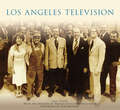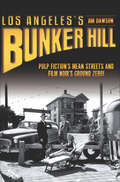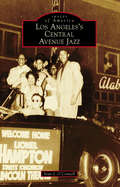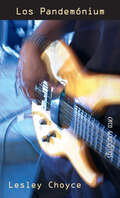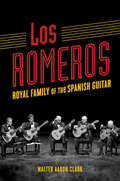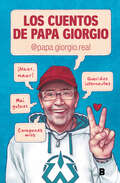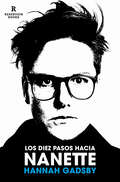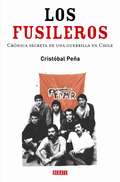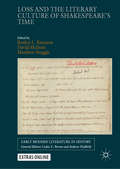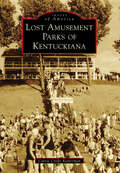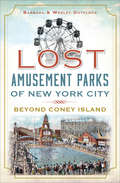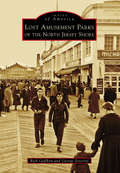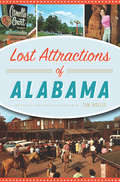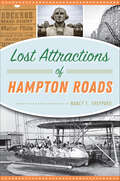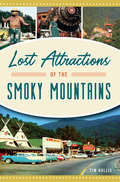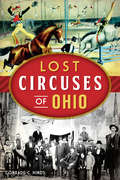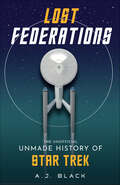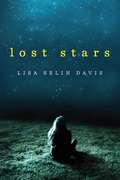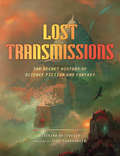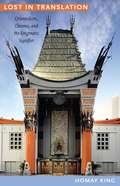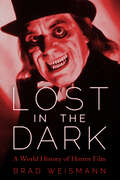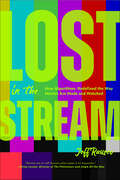- Table View
- List View
Los Angeles Television
by Joel Tator The Museum of Broadcast CommunicationsLos Angeles television history began in the small room of an auto dealership in 1931. Since then, much of the nation's television history has been made here: the first television helicopter, the first big story that television broke before newspapers, the first live coverage of an atomic bomb, and the careers of numerous icons like Betty White, Steve Allen, Liberace, Lawrence Welk, and Tennessee Ernie Ford. Many Los Angeles television personalities went on to network fame, including Tom Snyder, Tom Brokaw, Bryant Gumbel, Connie Chung, Maury Povich, Bob Barker, Bill Leyden, Ann Curry, Pat Sajak, and Regis Philbin. Readers will discover, in many untold stories, the origins of that curious building on top the Hollywood sign, Albert Einstein's must-see local program, Marilyn Monroe's video debut, a popular television star's last tragic performance, and the actual identities of legends Korla Pandit and Iron Eyes Cody. Also in these pages is the reveal of the Mystery Tower Sitter, the all-night amateur show, the big Las Vegas premiere telecast that was blown off the air, and the treasured performer who worked at one station for 65 years.
Los Angeles's Bunker Hill: Pulp Fiction's Mean Streets and Film Noir's Ground Zero!
by Jim DawsonAn illustrated history of the iconic Hollywood neighborhood featured in numerous film noir classics—and the shadowy story of how it disappeared. When postwar movie directors went looking for a gritty location to shoot their psychological crime thrillers, they found Bunker Hill, a neighborhood of fading Victorians, flophouses, tough bars, stairways, and dark alleys in downtown Los Angeles. Novelist Raymond Chandler had already used its real-life mean streets to lend authenticity to his hardboiled detective stories featuring Philip Marlowe. But the biggest crime of all was going on behind the scenes, run by the city&’s power elite. And Hollywood just happened to capture it on film. Using nearly eighty photos, writer Jim Dawson sheds new light on Los Angeles history with this grassroots investigation of a vanished place.
Los Angeles's Central Avenue Jazz
by Sean J. O'ConnellFrom the late 1910s until the early 1950s, a series of aggressive segregation policies toward Los Angeles's rapidly expanding African American community inadvertently led to one of the most culturally rich avenues in the United States. From Downtown Los Angeles to the largely undeveloped city of Watts to the south, Central Avenue became the center of the West Coast jazz scene, nurturing homegrown talents like Charles Mingus, Dexter Gordon, and Buddy Collette while also hosting countless touring jazz legends such as Duke Ellington, Louis Armstrong, and Billie Holiday. Twenty-four hours a day, the sound of live jazz wafted out of nightclubs, restaurants, hotel lobbies, music schools, and anywhere else a jazz combo could squeeze in its instruments for nearly 50 years, helping to advance and define the sound of America's greatest musical contribution.
Los Pandemónium: (Thunderbowl) (Spanish Soundings)
by Lesley ChoyceThunderbowl, la banda de Jeremy, es excelente, y acaba de conseguir su primera gran oportunidad: una serie de tocadas en el bar local. El problema es que Jeremy debería estar al corriente con sus trabajos para la escuela, pero pasa casi todas las noches en el escandaloso club tratando de mantener a la banda unida. Equilibrar los sueños de éxito con la realidad de la industria de la música obligará a Jeremy a tomar decisiones muy difíciles. Jeremy's band, Thunderbowl, is hot, and they have had their first big break—a long-term gig at a local bar. The problem is that while Jeremy should be keeping up with his school work, he is spending most nights in a rowdy club, trying to keep the band together. Balancing dreams of success with the realities of the music business force Jeremy to make tough choices.
Los Romeros: Royal Family of the Spanish Guitar (Music in American Life)
by Walter Aaron ClarkSpanish émigré guitarist Celedonio Romero gave his American debut performance on a June evening in 1958. In the sixty years since, the Romero Family—Celedonio, his wife Angelita, sons Celín, Pepe, and Angel, as well as grandsons Celino and Lito—have become preeminent in the world of Spanish flamenco and classical guitar in the United States. Walter Aaron Clark's in-depth research and unprecedented access to his subjects have produced the consummate biography of the Romero family. Clark examines the full story of their genius for making music, from their outsider's struggle to gain respect for the Spanish guitar to the ins and outs of making a living as musicians. As he shows, their concerts and recordings, behind-the-scenes musical careers, and teaching have reshaped their instrument's very history. At the same time, the Romeros have organized festivals and encouraged leading composers to write works for guitar as part of a tireless, lifelong effort to promote the guitar and expand its repertoire. Entertaining and intimate, Los Romeros opens up the personal world and unfettered artistry of one family and its tremendous influence on American musical culture.
Los cuentos de Papa Giorgio
by Papa GiorgioQue tiemblen los influencers y los streamers más top... ¡ha llegado Papa Giorgio, la auténtica estrella de internet! LAS LECCIONES DE VIDA DE PAPA GIORGIO PARA QUE NO TE CUENTEN CUENTOS «Queridos internautas (ahora lectores). Corazones míos. Amores de mi vida. Os llevo en my country, here. Quiero daros la bienvenida a este pequeño resumen sobre la vida de Papa Giorgio. Aquí os desvelo todo aquello que no se ve tras la pantalla: mis vivencias, mis experiencias, mis recuerdos más alegres y los más tristes. Los momentos que me hicieron sentir más vivo que nunca y también los que me hundieron.No quiero dejarme nada porque todo, absolutamente todo lo que he vivido, me ha servido para extraer aprendizajes. Y estas enseñanzas son mi regalo para vosotros».Con el mismo tono pícaro y divertido que ha conquistado a sus miles de seguidores en internet, Papa Giorgio nos cuenta sus anécdotas más épicas, sus secretos mejor guardados -se incluye una sabrosa telenovela al final del libro- y cómo un señor anónimo tuvo un hijo como Jordi Wild y de la noche a la mañana se convirtió él también sin pretenderlo en un fenómeno de las redes sociales.
Los diez pasos hacia Nanette: Memorias incómodas
by Hannah GadsbyHannah Gadsby desvela los momentos que definieron su vida y la llevaron a subir al escenario con toda la verdad por delante. «No hay nada más fuerte que una mujer rota que logra recomponerse».Hannah Gadsby, Nanette Nanette no fue solo un espectáculo de stand-up insuperable, fue también un arrollador éxito viral que cautivó al público por su sinceridad desgarrada y por su habilidad para generar a un mismo tiempo tensión y risa. El éxito mundial de Gadsby podría hacernos creer que la fama le llegó de la noche a la mañana, pero el camino que la llevó a lo más alto de la escena internacional fue en realidad bastante tortuoso. En Los diez pasos hacia Nanette, Gadbsy nos brinda su retrato más íntimo: su adolescencia como persona queer en Tasmania (donde la homosexualidad fue ilegal hasta 1997), los trabajos itinerantes en Australia tras la universidad, sus duros encontronazos con la homofobia y la violencia sexual, su constante evolución como cómica, los diagnósticos tardíos de autismo y TDAH... y finalmente el hallazgo de lo que había de ser la esencia de Nanette, es decir, la renuncia a mofarse de sí misma en sus chistes, el rechazo de la misoginia y el compromiso moral con decir la verdad a toda costa. Tan dura como divertida, Los diez pasos hacia Nanette es una «autobiografía incómoda» que, siguiendo la costumbre de su autora de jugar con las expectativas y las reglas de la comedia, nos acerca a una de las voces más explosivas e influyentes de nuestro tiempo. La crítica ha dicho:«Hannah es una fuerza prometeica, un talento revolucionario. Con este libro gracioso, conmovedor y a veces trágico lo que ha hecho es señalarnos dónde se originaron sus hogueras».Emma Thompson «Hannah Gadsby es la perfecta representación de la verdad que se esconde detrás de toda broma».La Vanguardia «Una clara muestra de todo lo bueno que puede pasar cuando una voz diferente se hace oír».Victoria Segal, The Times «Gadsby se muestra aquí como una escritora clara, inteligente y sustanciosa, capaz de hablarnos de sus años de formativos y de la evolución de su carrera y a la vez tocar temas relativos a la cultura popular, la política, la salud mental o el autismo».Steph Harmon, The Guardian «Un libro aparentemente de memorias que, sin embargo, escapa a toda convención y con el que Gadbsy logra, desde el núcleo irradiador que es su espectáculo más famoso, reconstruir con detalle su trayectoria vital».Thomas Floyd, The Washington Post «Sus fans comprobarán con sumo placer que Gadbsy, sobre el papel, es tan buena como sobre el escenario.»Trish Bendix, Time La crítica ha dicho sobre Nanette:«Nanette es un fenómeno internacional, el monólogo más comentado, reseñado y compartido en años, exquisitamente sincronizado con la era MeToo».The New York Times «Tan divertido como profundamente furioso».The New Yorker «Nanette es sencillamente extraordinaria. Me ha conmovido y me ha hecho reflexionar sobre el humor, el yo, el autodesprecio y los usos de la ira. Muchas gracias. Es simplemente brillante».Roxane Gay «Una hora y tres minutos. Ese es el tiempo que tarda Gadsby en destrozarte con sus palabras, ojos vidriosos y realidad sin filtros».El País «Jamás he llorado tan desconsoladamente en un espectáculo de comedia stand up».Monica Lewinsky
Los fusileros
by Cristóbal PeñaLa tarde del domingo 7 de septiembre de 1986, en el Cajón del Maipo, un comando del Frente Patriótico Manuel Rodríguez (FPMR) tendió una emboscada a la caravana que trasladaba al general Augusto Pinochet. La temeraria acción pasó a la historia y sus protagonistas - entre los que se contaban un escolar, un gásfiter, un bombero, un fisicoculturista, un cantautor, un ex seminarista de Schoenstatt y un estudiante de Cine y otro de Filosofía- cayeron en el olvido y corrieron suertes dispares. Narrada en clave de thriller político y policial, esta crónica acude al presente para reconstruir la historia de los veintiún fusileros que esa tarde de domingo desafiaron al régimen, convencidos de que no saldrían con vida.
Los mariachis de Adela
by Denise VegaAdela ama todo sobre la banda mariachi de su familia, ¡excepto que ella no forma parte de la banda! Poniendo un foco de atención en la música mexicana, llena de instrumentos y bailes, ¡La banda de Adela seguramente será un éxito!Adela loves everything about her family's mariachi band--except that she isn't in it! Shining a spotlight on Mexican music, full of instruments and dancing, Adela&’s Band is sure to be a hit!Adela no desea nada más que ser parte de la banda mariachi de su familia, pero cuando intenta tocar los diferentes instrumentos, todo sale mal. La trompeta hace un ruido extraño, la vihuela emite un ruido agudo y desagradable, y cuando intenta bailar, Adela se cae al suelo. Observando a su familia, Adela sabe que la práctica hace al maestro, ¿pero podrá encontrar una manera de ser parte de la banda en el entretanto?Contado en una estructura repetitiva y divertida, ¡este libro ilustrado rítmico incorpora divertidos sonidos de instrumentos y vocabulario en español!Adela wants nothing more than to be a part of her family's mariachi band, but when she tries the different instruments, everything comes out wrong. La trompeta fizzles, la vihuela squeaks, and trying to dance makes Adela fall on her face. From watching her family, Adela knows that practice makes perfect, but can she find a way to be part of the band in the meantime?A new go-to read-aloud favorite that comes complete with funny instrument sounds, a rythmic text, and Spanish vocabulary. Strike up the band!
Losing Tempo (Band Together)
by Keith WainEveryone is too busy for the band. Well, everyone except Lewis. He needs to find a way to bring the band back together.
Loss and the Literary Culture of Shakespeare’s Time (Early Modern Literature in History)
by Matthew Steggle Roslyn L. Knutson David McInnisAs early modernists with an interest in the literary culture of Shakespeare’s time, we work in a field that contains many significant losses: of texts, of contextual information, of other forms of cultural activity. No account of early modern literary culture is complete without acknowledgment of these lacunae, and although lost drama has become a topic of increasing interest in Shakespeare studies, it is important to recognize that loss is not restricted to play-texts alone. Loss and the Literary Culture of Shakespeare’s Time broadens the scope of the scholarly conversation about loss beyond drama and beyond London. It aims to develop further models and techniques for thinking about lost plays, but also of other kinds of lost early modern works, and even lost persons associated with literary and theatrical circles. Chapters examine textual corruption, oral preservation, quantitative analysis, translation, and experiments in “verbatim theater”, plus much more.
Lost Amusement Parks of Kentuckiana (Images of America)
by Carrie Cooke KettermanThe banks of the Ohio River, where picnic grounds flourished and steamboat travel was abundant, provided an ideal location for amusement parks to thrive in Kentuckiana, a term used to describe the Louisville and southern Indiana area. Popular amusement parks such as Glenwood Park, Rose Island, White City, Fontaine Ferry, and Kiddieland welcomed visitors as early as 1902, and the more successful parks continued to operate well into the 1960s. Visitors to these parks enjoyed steamboat excursions, live music, rides, games, picnics, sporting events, and more. These parks were not only for amusement seekers but also for keen businessmen like David Rose, who purchased Fern Grove in 1923 and renamed the park Rose Island. Transportation businesses thrived, with steamboats like the Idlewild (now the Belle of Louisville) providing regular transportation to the parks along the Ohio River. In addition to an increase in river traffic, companies like the New Albany Traction Company purchased the area that would become Glenwood Park from the well-known Beharrel family, of New Albany, Indiana, and provided rail transportation to their park.
Lost Amusement Parks of New York City: Beyond Coney Island (Lost Ser.)
by Wesley Gottlock Barbara GottlockA historical tour of fun and frolic in the five boroughs—including photos from the good old days. Coney Island is an iconic symbol of turn-of-the-century New York—but many other amusement parks have thrilled the residents of the five boroughs. Strategically placed at the end of trolley lines, railways, public beaches, and waterways, these playgrounds for the rich and poor alike first appeared in 1767. From humble beginnings, they developed into huge sites like Fort George, Manhattan&’s massive amusement complex. Each park was influenced by the culture and eclectic tastes of its owners and patrons—from the wooden coasters at Staten Island&’s Midland Beach to beer gardens on Queens&’ North Beach and fireworks blasting from the Bronx&’s Starlight Park. As real estate became more valuable, these parks disappeared. With this historical tour, you can rediscover the thrills of the past from the lost amusement parks of New York City.
Lost Amusement Parks of the North Jersey Shore (Images of America)
by George Severini Rick GeffkenThe Jersey Shore has always attracted people seeking relief from summer heat and humidity. Long before Europeans came here, the native Lenape clammed, fished, and played games on the beach and in the surf. These original people could scarcely have imagined that, by the end of the 19th century, the 120-mile-long coastline of New Jersey would be dotted with amusement parks featuring gentle kiddie car rides, terrifying roller coasters, merry-go-rounds, and fast-food emporiums. James Bradley in Asbury Park and William Sandlass Jr. in Highland Beach created mass entertainment for hundreds of thousands of people. Their seaside recreation centers, along with those in Long Branch, Bradley Beach, Pleasure Bay, and others, endured for years but are just fond and fading memories today.
Lost Attractions of Alabama
by Tim HollisAlabama has had an enviable success rate when it comes to tourist attractions, with some that date back to the 1930s still drawing crowds today. But many others have come and gone, sometimes leaving little evidence of their existence. Join Alabama native Tim Hollis as he revisits iconic attractions such as Canyon Land Park and Sequoyah Caverns, the floral clock at Birmingham's Botanical Gardens and the traffic safety torch held aloft by Vulcan, the iron man. Many Gulf Coast attractions are gone, including Styx River Water World and Spooky Golf, but the memories remain.
Lost Attractions of Hampton Roads (Lost)
by Nancy E. SheppardTake a trip down memory lane to beloved destinations for fun and families across Virginia's tidewater.Cruise the rails of Ocean View Amusement Park's "The Rocket" roller coaster, dig for fossils at Hampton's Rice's Fossil Pit, celebrate the winter season at Portsmouth's Coleman's Nursery and learn the significant role that Buckroe Beach's Bay Shore Beach Park played in American history. From the Great White Fleet to a Wild West park, journey through this vibrant history with author and historian Nancy E. Sheppard and discover whether such cherished places can ever truly be lost.
Lost Attractions of the Smoky Mountains (Lost)
by Tim HollisThe Great Smoky Mountains National Park is among the most visited national parks in the country, and countless attractions around its borders have tried for decades to siphon some of those valuable tourist dollars. From ersatz western towns and concrete dinosaurs to misplaced Florida-type attractions and celebrity theaters, you will find them all preserved in this book. Author Tim Hollis showcases those businesses that no longer exist, from Hill-Billy Village in Pigeon Forge and Gatlinburg's theme parks on the Tennessee side to the motels of Cherokee and Ghost Town in the Sky on the North Carolina side.
Lost Circuses of Ohio (Lost)
by Conrade C. HindsThe nineteenth century was the golden age of the circus in Ohio. Before the Ringling brothers became synonymous with the American circus, Cincinnati's John Robinson and the Sells brothers of Columbus wowed audiences with stunning equestrian feats and aerial exploits. For good measure, the Sells brothers threw in a sharpshooting show with a young Ohio woman by the name of Annie Oakley. The Walter L. Main Circus of Geneva and a number of smaller shows presented their own unique spectacles with exotic animals and daring acrobats. But for all the fun and games, Ohio's circus industry was serious business. As competition intensified, advertising wars erupted and acquisitions began. Eventually, Ringling Brothers swallowed many of these circuses one by one, and they dropped out of memory. Author Conrade C. Hinds brings this fascinating piece of Ohio show business back into the spotlight.
Lost Federations: The Unofficial Unmade History of Star Trek
by A. J. Black"An innovative and unusual account of Star Trek’s lost voyages that makes for a fascinating alternate history." — Brian J. Robb in Sci-Fi Bulletin SPACE. THE FINAL FRONTIER. THESE WERE ALMOST THE VOYAGES OF THE STARSHIP ENTERPRISE. We think we know the history of Star Trek. Born at the height of 1960s popular culture, the five-year mission of Captain James T. Kirk and his crew faced early cancellation, bounced back with a series of beloved movies in the 1980s and gave way to a fleet of successful sequels and spin-offs that kept on exploring strange new worlds. In Lost Federations: The Unofficial Unmade History of Star Trek, author A. J. Black tells a different story. This is an alternate history of the franchise, one filled with roads not taken, from early 1960s feature-films and spin-offs, the original sequel Star Trek: Phase II in the 1970s, via epic planned movies such as Planet of the Titans and into many untold episodes, arcs and character stories from The Next Generation, Deep Space Nine and Voyager, all the way through to the modern era. Bringing together pre-existing material over decades for the first time in one space, plus some new reflections from Star Trek writers and analysis of how it all fits into the wider cultural trends of the last sixty years, Lost Federations invites you to boldly explore a history you may not already know...
Lost Stars (A Broken Code #1)
by Lisa Selin DavisEleanor & Park meets Perks of Being a Wallflower in this bittersweet 1980’s story about love, loss, and a comet that only comes around every ninety-seven years. When Carrie looks through her telescope, the world makes sense. It’s life here on Earth that’s hard to decipher. Since her older sister, Ginny, died, Carrie has been floating in the orbit of Ginny’s friends, the cool kids, who are far more interested in bands and partying than science. Carrie’s reckless behavior crosses a line, and her father enrolls her in a summer work camp at a local state park. There, Carrie pulls weeds and endures pep talks about the power of hard work. Despite her best efforts to hate the job, Carrie actually feels happy out in nature. And when she meets Dean—warm, thoughtful, and perceptive—she starts to discover that her life can be like her beloved night sky, with black holes of grief for Ginny and dazzling meteors of joy from first love.
Lost Transmissions: The Secret History of Science Fiction and Fantasy
by Desirina BoskovichThis illustrated journey through lost, overlooked, and uncompleted works is &“a fascinating enrichment of the history of sf and fantasy&” (Booklist). Science fiction and fantasy reign over popular culture now, associated in our mind with blockbuster movies and massive conventions. But there&’s much more to the story than the headline-making hits. Lost Transmissions is a rich trove of forgotten and unknown, imagined-but-never-finished, and under-appreciated-but-influential works from those imaginative genres, as well as little-known information about well-known properties. Divided into sections on Film & TV, Literature, Art, Music, Fashion, Architecture, and Pop Culture, the book examines: Jules Verne&’s lost novelAfroFuturism and Space DiscoE.T.&’s scary beginningsWilliam Gibson&’s never-filmed Aliens sequelWeezer&’s never-made space operathe 8,000-page metaphysical diary of Philip K. Dick, and more Featuring more than 150 photos, this insightful volume will become the bible of science fiction and fantasy&’s most interesting and least-known chapters. &“Will broaden your horizons and turn you on to wonders bubbling under the mass-market commodified pleasures to which we all too often limit ourselves.&” —The Washington Post
Lost in Translation: Orientalism, Cinema, and the Enigmatic Signifier
by Homay KingIn a nuanced exploration of how Western cinema has represented East Asia as a space of radical indecipherability, Homay King traces the long-standing association of the Orient with the enigmatic. The fantasy of an inscrutable East, she argues, is not merely a side note to film history, but rather a kernel of otherness that has shaped Hollywood cinema at its core. Through close readings of The Lady from Shanghai, Chinatown, Blade Runner, Lost in Translation, and other films, she develops a theory of the "Shanghai gesture," a trope whereby orientalist curios and dcor become saturated with mystery. These objects and signs come to bear the burden of explanation for riddles that escape the Western protagonist or cannot be otherwise resolved by the plot. Turning to visual texts from outside Hollywood which actively grapple with the association of the East and the unintelligible--such as Michelangelo Antonioni's Chung Kuo: Cina, Wim Wenders's Notebook on Cities and Clothes, and Sophie Calle's Exquisite Pain--King suggests alternatives to the paranoid logic of the Shanghai gesture. She argues for the development of a process of cultural "de-translation" aimed at both untangling the psychic enigmas prompting the initial desire to separate the familiar from the foreign, and heightening attentiveness to the internal alterities underlying Western subjectivity.
Lost in the Dark: A World History of Horror Film
by Brad WeismannTwo horror films were nominated for the Academy Award for Best Picture in 2018, and one of them—The Shape of Water—won. Since 1990, the production of horror films has risen exponentially worldwide, and in 2013, horror films earned an estimated $400 million in ticket sales. Horror has long been the most popular film genre, and more horror movies have been made than any other kind. We need them. We need to be scared, to test ourselves, laugh inappropriately, scream, and flinch. We need to get through them and come out, blinking, still in one piece. Lost in the Dark: A World History of Horror Film is a straightforward history written for the general reader and student that can serve as a comprehensive reference work. The volume provides a general introduction to the genre, serves as a guidebook to its film highlights, and celebrates its practitioners, trends, and stories. Starting with silent-era horror films and ending with 2020’s The Invisible Man, Lost in the Dark looks at decades of horror movies. Author Brad Weismann covers such topics as the roots of horror in literature and art, monster movies, B-movies, the destruction of the American censorship system, international horror, torture porn, zombies, horror comedies, horror in the new millennium, and critical reception of modern horror. A sweeping survey that doesn’t scrimp on details, Lost in the Dark is sure to satisfy both the curious and the completist.
Lost in the Funhouse: The Life and Mind of Andy Kaufman
by Bill ZehmeFrom renowned journalist Bill Zehme, author of theNew York TimesbestsellingThe Way You Wear Your Hat: Frank Sinatra and the Lost Art of Livin', comes the first full-fledged biography and the only complete story of the late comic genius Andy Kaufman. Based on six years of research, Andy's own unpublished, never-before-seen writings, and hundreds of interviews with family members, friends, and key players in Andy's endless charades, many of whom have become icons in their own right,Lost in the Funhousetakes us through the maze of Kaufman's mind and lets us sit deep behind his mad, dazzling blue eyes to see, firsthand, the fanciful landscape that was his life. Controversial, chaotic, splendidly surreal, and tragically brief--what a life it was. Andy Kaufman was often a mystery even to his closest friends. Remote, aloof, impossible to know, his internal world was a kaleidoscope of characters fighting for time on the outside. He was as much Andy Kaufman as he was Foreign Man (dank you veddy much), who became the lovably bashful Latka on the hit TV seriesTaxi. He was as much Elvis Presley as he was the repugnant Tony Clifton, a lounge singer from Vegas who hated any audience that came to see him and who seemed to hate Andy Kaufman even more. He was a contradiction, a paradox on every level, an artist in every sense of the word. During the comic boom of the seventies, when the world had begun to discover the prodigious talents of Steve Martin, Richard Pryor, John Belushi, Bill Murray, and so many others, Andy was simply doing what he had always done in his boyhood reveries. On the debut ofSaturday Night Live,he stood nervously next to a phonograph that scratchily played the theme from Mighty Mouse. He fussed and fidgeted, waiting for his moment. When it came, he raised his hand and moved his mouth to the words "Here I come to save the day!" In that beautiful deliverance of pantomime before the millions of people for whom he had always dreamed about performing, Andy triumphed. He changed the face of comedy forever by lurching across boundaries that no one knew existed. He was the boy who made life his playground and never stopped playing, even when the games proved too dangerous for others. And in the end he would play alone, just as he had when it was all only beginning. InLost in the Funhouse, Bill Zehme sorts through a life of disinformation put forth by a master of deception to uncover the motivation behind the manipulation. Magically entertaining, it is a singular biography matched only by its singular subject.
Lost in the Stream: How Algorithms Redefined the Way Movies Are Made and Watched
by Jeff RauseoExplore Cinema History, Stream Your FavoritesThis engaging book by Jeff Rauseo blends film history with a modern guide to streaming, helping you navigate the complex history of movie making and ultimately how to know what to watch in the vast ocean of content. From the golden age of Hollywood to the best new movies to stream, Rauseo breaks down the ever-evolving movie watching experience to help us understand the good, the bad, and the ugly of streaming.Ever feel overwhelmed by endless streaming choices? Jeff Rauseo&’s Lost in the Stream is your ultimate roadmap, combining movie history insights with an in-depth breakdown of how streaming influences the movies that are made and the ones that we are shown. Whether you&’re searching for the best new movies to stream, hidden Amazon Prime movies, or fun movies to watch on Netflix, this book has you covered. Blending nostalgia with today&’s streaming hits, Lost in the Stream dives deep into the iconic history of film that shaped the art while helping you discover new favorites. It&’s the perfect companion for movie buffs and casual viewers alike. Inside, you'll find: A breakdown of the evolution of film watching, from drive-ins to Blockbuster nights and beyond Engaging insights into the impact finances and algorithms have on the movies that are made A guide to discovering the best films for you Never Wonder What to Watch Again.If you liked The New York Times Book of Movies, The Science of Interstellar, or Oscar Wars, you&’ll love Lost in the Stream.
